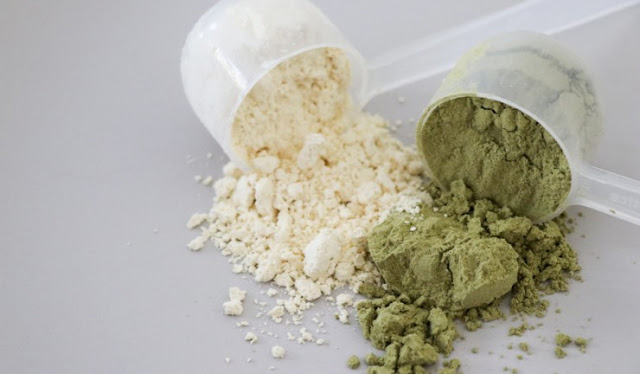
Protein powder important
Protein powder important
- Protein produces bigger muscles
Protein powder / Protein is important for your body to function optimally when working out with heavy weights. If you meet your daily need for protein powder then you will get bigger muscles. And bigger muscles are the reason young people exercise fitness. Therefore, it is popular to take protein as a dietary supplement. It is also recommended to eat protein-rich foods combined with a shake packed with muscle-building proteins. In fact, the optimal thing is to feed your body protein in smaller doses. Protein as a supplement can get in different types - the most widely used is whey protein, as it tastes good, has a functional effect, and is easily soluble. Bodylab Protein is a well-known brand in Denmark, where uncompromising quality is the key word in a protein product that lives up to the high food requirements in Danish food legislation.
In order to get the most out of your workout, it is vital to meet your need for macronutrients. The 3 macronutrients your body needs are protein powder , fat and carbohydrates. And just carbohydrates we will take a closer look at in this article.Carbohydrates are a term for those substances in the food that contain carbon, hydrogen and oxygen. Foods rich in carbohydrates e.g. bread, pasta, rice, grains, vegetables, fruit etc. It is important to point out that the carbohydrates found in the different food types are not the same. There is a big difference in carbohydrates. Carbohydrates are mainly divided into 2 main groups. The digestible carbohydrates and the indigestible carbohydrates. The digestible carbohydrates consist of the following.
sugar (sucrose)
grape sugar (glucose)
- Fruit sugar ( fructose)
- Milk sugar (lactose)
- Starch
All of the digestible carbohydrates in the body will be converted to glucose, and subsequently either burned, or stored as glycogen in the liver and muscles.
The indigestible carbohydrates consist of the following: -
-Water-soluble dietary fiber
- Water-insoluble dietary fiber
Dietary fiber is as its name indicates indigestible. However, they are consumed by bacteria in the colon, and at the same time contribute to maintaining good digestion. At the same time, there are numerous studies showing that fibers counteract certain cancers of the digestive system.
carbohydrate metabolism
The carbohydrates we eat ultimately have the same fate, regardless of the source of carbohydrate. Namely, it is being converted into ATP. ATP stands for Adenosine Tri-Phosphate and is the energy source used by all cells in the body.
As mentioned, the carbohydrates are converted to glucose and are transported to the cells that need it via the blood stream. If the need for glucose is saturated, then the glucose is converted into glucose, and stored in the liver or muscles.
Carbohydrate metabolism, including ATP production, is a very complex topic, and we will therefore not go down and look at the biochemical processes that underlie the production of the individual biochemical substances. However, we will go into some of the biochemical concepts that describe the different transformation.
- Glucogenolysis = describes the biochemical process in which the stored glucogen is converted to glucose.- Glucogenesis = describes the biochemical process where glucose is converted to glucogen and stored in muscles and liver.
- Glucolysis= describes the biochemical process where glucose is converted to pyruvate, which in turn is converted to pyruvate dehydrogenase or lactate, depending on whether oxygen is present during the process. The whole purpose of glucose is to create ATP.
- Gluconeogenesis = describes the biochemical process where lactate (or other biochemical substances) is converted to glucogen.
Glucogenolysis occurs in situations where glucose turnover is high. In sports situations glucose glucose analysis will be very active as glucose consumption is extremely high.
Glucogenesis occurs when our glucogen depots are not filled. When we get home from training, with depleted glucogen depots, the glucogen works on high pressure. This is of course understood that after training we eat a meal rich in carbohydrates.
Glucolysis occurs in all cells, all the time. The purpose is to create the vital ATP so that the cells can get the energy they need. It can happen either by consuming oxygen. Here, glucose -> pyruvate -> pyruvate dehydrogenase is converted, which is then part of the complex biochemical process called citric acid cycle, or TCA. The whole purpose of TCA is, as I said, to produce ATP. It can also be done without the consumption of oxygen, and here glucose -> pyruvate -> lactate is converted, which in turn gives ATP.
Gluconeogenesis is actually the opposite of glucolysis. Where glucose provides ATP, by cleavage of glucose, then gluconeogenesis requires ATP to produce glucose. And when glucose is to be produced, it can probably be calculated that it occurs in a situation where food intake, or more specifically, carbohydrates
You may immediately think that the above is a bit dry and boring, but it is extremely important to understand these basic processes in order to understand a wide range of phenomena in the body. Let me give you an example. The body's total muscle mass is an important part of the overall burn. It is therefore important that we maintain muscle mass as best we can. Those who go on starvation or on diets with extremely low carbohydrate content thereby activate gluconeogenesis. When the calorie deficit is extremely low, the body has to produce biochemical substances that can be converted to glucose, as it is vital for, among other things, brain activity. It does this, among other things, by breaking down muscle tissue. By breaking down muscle tissue,
The glycemic index
In practice, the glycemic index is perhaps most interesting for diabetics, as attention should be paid to the role of individual foods on blood sugar concentration. The reason why the glycemic index is unattractive in practice is that it is rare for a meal to consist of only a portion of pasta. A meal consists of many different parts, and for a portion of pasta you may typically consume some meat sauce and some grated cheese. And so the rise in blood sugar b
The fate of carbohydrates starts in the mouth. In our saliva there is an enzyme called amylase. Amylase starts the breakdown of carbohydrates. However, the amylase activity stops in the stomach as the stomach acid denatures and destroys the amylase. The task of the stomach acid is not to split the food chemically. The task of the stomach acid is to make the food fragments smaller so that the small intestine can continue the chemical breakdown that started in the mouth. Again, the enzyme amylase is responsible for the task. This time it comes via the digestive secretion that the pancreas "pumps" into the small intestine. How fast carbohydrates pass through the small intestine depends on the complexity of carbohydrates and whether fiber is present in the meal.
The glycemic index is a number that describes how much blood sugar rises when we eat a given type of carbohydrate. You compare the blood sugar rise of the food in question with the blood sugar increase you get when consuming grape sugar. The ratio or percentage you get is called the glycemic index. For example, if you eat a piece of fruit with a glycemic index of 38, it means that the blood sugar response is 38 percent of the blood sugar response you produce with the same amount of grape sugar.




0 Response to " Protein powder important"
Post a Comment
Please don't enter any spam link